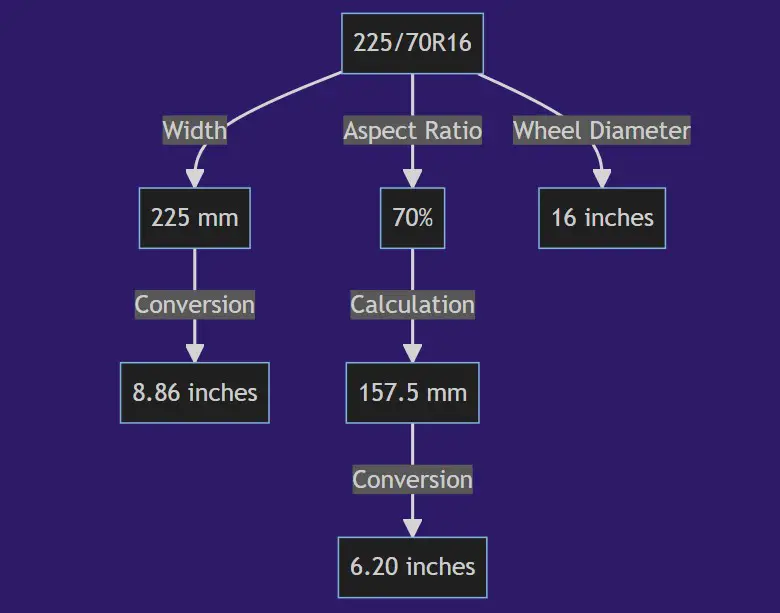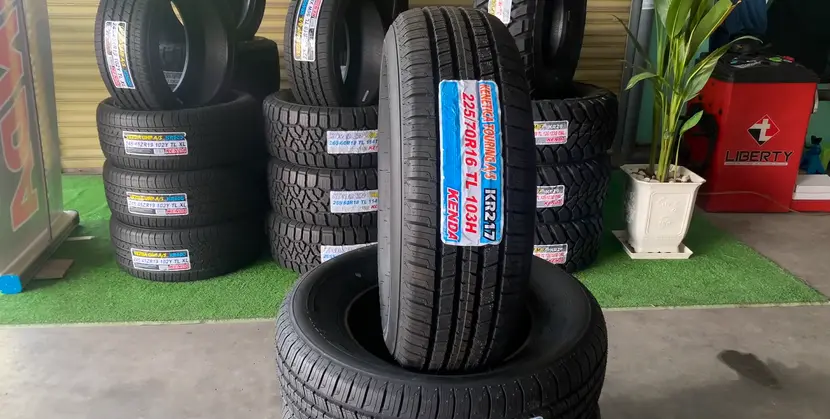The 225/70R16 tire features a diameter of about 28.4 inches and a width of around 8.9 inches, made for a 16-inch rim. In high flotation terms, it would be 28.4×8.9R16.

What does 225/70r16 Tire mean?
Before we break into the inches and millimeters, let’s first decode the numbers in the tire size 225/70r16. Take a look at the table below, where we’ve listed each section of the tire measurement and its corresponding explanation.
| Tire Number | Its Explanation |
|---|---|
| 225 | This is the section width of the tire, measured in millimeters. It represents the width of the tire from sidewall to sidewall. |
| 70 | This is the aspect ratio of the tire. It’s the height of the tire’s cross-section to its width. It means the height is 70% of the tire’s width. |
| R | The “R” stands for radial, which means the layers run radially across the tire. |
| 16 | This represents the wheel diameter. It’s the size of the wheel from one end to the other, and it’s measured in inches. |
Now that we have decoded the mysterious numbers and letters, let’s get into the nitty-gritty details: converting these measurements into inches and millimeters!
What is 225/70r16 Tire in inches?
Now comes the tricky part, converting the tire size from its alphanumeric format to actual dimensions. A 225/70r16 tire size translates into specific measurements in inches and millimeters. Remember, converting units is not a “re-tire-ing” task (get it?). We’ve taken the liberty of doing the calculations for you. Below is a table showing these measurements for a 225/70r16 tire.
| Measurement | Inches | Millimeters |
|---|---|---|
| Tire Diameter | 28.4 | 721 |
| Section Width | 8.9 | 225 |
| Rim Diameter | 16 | 406 |
| Sidewall Height | 6.2 | 157.5 |
| Circumference | 89.1 | 2,263 |
| Revolutions per mile | 711 | 711 |
A Deeper Dive into the 225/70r16 Tire Specifications
Now that we’ve covered the basics of the 225/70r16 tire size, let’s take a deeper dive into its specifications. Get ready to explore the wide world of tire width, height, sidewalls, rim diameter, and even the magical circumference. We’re about to make your tire knowledge soar higher than a runaway tire on the freeway!

Tire width of 225/70r16: Unleashing the Beast’s Girth
When it comes to the width of a 225/70r16 tire, we’re talking about some serious girth. Imagine a tire that measures approximately 8.9 inches or a jaw-dropping 225 millimeters from sidewall to sidewall. That’s wider than a sumo wrestler trying to squeeze into skinny jeans! With this tire, you can be sure to have excellent stability and grip on the road. It’s like having a trusty sidekick that hugs the pavement like nobody’s business.
Tire height of 225/70r16: From the Ground Up
Next up, we have the tire height. The 225/70r16 tire stands tall with a height of approximately 6.2 inches or 157.5 millimeters. That’s taller than a stack of your favorite pancakes drenched in syrup! The height plays a crucial role in maintaining your car’s overall balance and ensuring a comfortable ride. So, think of this tire as your trusty co-pilot, always ready to take your vehicle to new heights (literally!).
Sidewall height of 225/70r16: The Tire’s Secret Tattoo
Ah, the sidewall height, the hidden tattoo of the tire. In the case of the 225/70r16, the sidewall height measures around 6.2 inches or 157.5 millimeters. This measurement represents the distance between the rim and the outer edge of the tire. Think of it as the tire’s own personal bodyguard, shielding it from bumps, potholes, and the occasional rogue pebble. With a sidewall height like this, your tire is prepared to tackle any road obstacle that comes its way.
Rim diameter for 225/70r16: Embracing the Perfect Fit
Now, let’s move on to the rim diameter. For the 225/70r16 tire, you’ll need a rim with a diameter of precisely 16 inches. Picture this: a wheel that’s as sweet and round as a perfectly baked pizza crust (cue the rumbling stomachs!). This tire and rim duo is a match made in automotive heaven, ensuring a snug fit and optimal performance. It’s like finding your car’s perfect dance partner, gliding across the asphalt in perfect harmony.
Tire circumference of 225/70r16: Unraveling the Mystical Path
Last but certainly not least, we have the tire circumference. Brace yourself for some mind-blowing data! The 225/70r16 tire wraps around the wheel, forming a circumference of approximately 89.1 inches or a mesmerizing 2,263 millimeters. That’s enough tire to circle a racetrack like a champion NASCAR driver or to play a game of “guess the tire length” with your fellow tire enthusiasts. This circumference affects various aspects of your vehicle’s performance, from speedometer accuracy to gear ratios. So, make sure you have your calculations on point!
What are the best 225/70r16 tires?
Now that we’ve covered the technical aspects of the 225/70r16 tire size, it’s time to find the perfect set of wheels for your ride. We’ve scoured the tire market, consulted with fellow experts, and even tapped into the wisdom of the tire gods to bring you the top 3 contenders. Buckle up, because these tires are ready to take you on a gripping adventure!
1 – Yokohama Geolandar AT G015 225/70R16 103H
Description: The Yokohama Geolandar AT G015 is a true off-road warrior that doesn’t shy away from rough terrain. With its aggressive tread design and durable construction, this tire will conquer any trail with ease. Not only does it offer outstanding traction on mud, snow, and gravel, but it also provides a smooth and comfortable ride on the highway.
Key Features:
- Aggressive tread pattern for excellent off-road traction
- Three-ply construction for enhanced durability and puncture resistance
- Optimized tread design for reduced road noise and improved fuel efficiency
Pros:
- Impressive off-road capabilities
- Comfortable and quiet on paved roads
- Long-lasting tread life
Cons:
- Slightly higher price point
- Limited availability in certain regions
Final Recommendation: If you’re an adventure seeker looking to conquer both the trails and the road, the Yokohama Geolandar AT G015 is your perfect match. Its versatility, durability, and exceptional performance make it a top choice for off-road enthusiasts.
2 – Hankook Kinergy ST (H735) All-Season Radial Tire – 225/70R16 101H
Description: The Hankook Kinergy ST (H735) is a reliable all-season tire that delivers excellent performance in various weather conditions. Designed with advanced technology, this tire offers a balance of comfort, durability, and fuel efficiency. Whether you’re cruising on the highway or navigating city streets, the Kinergy ST has got you covered.
Key Features:
- All-season tread compound for enhanced grip in wet and dry conditions
- Optimized block design for improved handling and stability
- Low rolling resistance for increased fuel efficiency
Pros:
- Excellent traction on different road surfaces
- Smooth and comfortable ride
- Affordable price point
Cons:
- Not designed for off-road or extreme winter conditions
- Slightly shorter tread life compared to some competitors
Final Recommendation: For a reliable and versatile all-season tire that offers a comfortable ride and good traction, look no further than the Hankook Kinergy ST (H735). It’s an affordable option that strikes a balance between performance and value.
3 – Hankook Kinergy ST H735 All-Season Radial Tire – 225/70R16 103T
Description: The Hankook Kinergy ST H735 is a true all-season performer, designed to deliver reliable traction and a comfortable ride throughout the year. With its advanced tread compound and optimized tread pattern, this tire offers excellent grip on both wet and dry surfaces. It’s an ideal choice for everyday driving and will keep you cruising smoothly and confidently.
Key Features:
- All-season tread compound for reliable traction in various weather conditions
- Wide circumferential grooves for improved water evacuation and resistance to hydroplaning
- Comfortable and quiet ride for a pleasant driving experience
Pros:
- Good handling and braking performance
- Long-lasting tread life
- Affordable price
Cons:
- Not intended for extreme winter conditions
- Limited off-road capabilities
Final Recommendation: For those seeking a dependable and versatile all-season tire, the Hankook Kinergy ST H735 is a solid choice. With its balanced performance, long-lasting tread, and reasonable price, it ticks the boxes for everyday driving needs.
4 – Firestone Winterforce 2 UV Studdable Winter/Snow Tire – 225/70R16 103S
Description: When winter unleashes its icy wrath, the Firestone Winterforce 2 UV is the tire you want on your side. Built specifically for cold-weather conditions, this studdable winter/snow tire provides outstanding traction on snowy and icy surfaces. With its aggressive tread pattern and enhanced biting edges, you’ll tackle winter roads with confidence and peace of mind.
Key Features:
- Winter tread compound for enhanced grip in snow and ice
- High-density siping for improved traction on slippery surfaces
- Studdable design for even greater winter performance
Pros:
- Excellent traction on snow and ice
- Reliable braking and handling in winter conditions
- Studdable for added versatility in extreme winter regions
Cons:
- Increased road noise compared to all-season tires
- Reduced fuel efficiency
Final Recommendation: When winter strikes, the Firestone Winterforce 2 UV is your trusty companion. With its snow-slaying capabilities and exceptional winter performance, this tire will keep you safe and in control on the frosty roads.
5 – Hankook Dynapro AT2 RF11 All-Terrain Radial Tire – 225/70R16 103T
Description: The Hankook Dynapro AT2 RF11 is an all-terrain beast that thrives in both on-road and off-road conditions. Engineered with ruggedness in mind, this tire combines aggressive off-road capabilities with excellent on-road manners. It boasts a durable construction and enhanced traction, making it perfect for adventurous souls seeking to explore the unbeaten path.
Key Features:
- Aggressive tread design for superior off-road traction
- Sidewall protectors for increased durability against cuts and abrasions
- Specially formulated tread compound for long-lasting performance
Pros:
- Exceptional off-road capabilities
- Good on-road stability and handling
- Enhanced durability for rugged adventures
Cons:
- Slightly compromised road noise and ride comfort compared to all-season tires
- Reduced fuel efficiency
Final Recommendation: If you’re an off-road enthusiast looking to conquer new horizons, the Hankook Dynapro AT2 RF11 is your go-to tire. With its outstanding off-road performance and rugged durability, it will take you on thrilling adventures without breaking a sweat.
FAQ’s About 225/70r16 Tire
Got burning questions about the 225/70r16 tire size? Don’t worry, we’re here to answer them all and put those tire-related mysteries to rest. Whether you’re curious about compatible vehicles, air pressure, or even the price tag, we’ve got you covered. Get ready for some tire-iffic knowledge!
Q: What vehicles use 225/70r16 Tires?
A: The 225/70r16 tire size is a popular choice for a variety of vehicles, including SUVs, crossovers, and some light trucks. Models like the Ford Escape, Jeep Cherokee, Toyota RAV4, and Honda CR-V are just a few examples of vehicles that can rock these tires. So, if you’re driving a compact SUV or a capable off-road machine, chances are the 225/70r16 is in your tire playbook!
Q: How many revolutions per mile does a 225/70r16 have?
A: Buckle up for some tire math! On average, a 225/70r16 tire completes approximately 711 revolutions per mile. That’s a lot of spinning action happening beneath your vehicle! So, next time you’re on a road trip, just imagine your tires putting on a show, twirling and swirling their way through the miles.
Q: What is the price of a 225/70r16 tire?
A: Ah, the cost of tires—a topic that can make your wallet cringe. The price of a 225/70r16 tire can vary depending on the brand, tire model, and any additional features. On average, you can expect to find options ranging from $100 to $200 per tire. However, it’s important to remember that investing in quality tires is a smart move for your safety and driving experience. So, let’s put the “tire-ible” puns aside and prioritize finding the best value for your money.
Q: What kind of rim does a 225/70r16 tire fit on?
A: The 225/70r16 tire size is designed to fit on a 16-inch rim diameter. So, when shopping for tires, make sure to check that your vehicle’s rims are compatible with this size. It’s like finding the perfect pair of shoes—make sure they fit snugly and match your style!
Q: How much air should be in a 225/70r16 tire?
A: Proper tire inflation is crucial for optimal performance and safety. The recommended air pressure for a 225/70r16 tire typically falls within the range of 30 to 35 psi (pounds per square inch). However, it’s always best to refer to your vehicle’s owner’s manual or the tire manufacturer’s recommendations for the specific air pressure required. Think of it as giving your tires a cozy hug—just not too tight!
Q: What is a 225/70r16 equivalent to?
A: If you’re ever in need of a tire size conversion or an equivalent size for a 225/70r16, you’re in luck! The closest equivalent to a 225/70r16 is a 235/65r16 tire. This size offers a similar overall diameter and width, providing a comparable fit for your vehicle.
Comparison with similar tires
When it comes to tire sizes, finding the perfect fit for your vehicle can be as thrilling as finding a matching pair of socks. To help you make an informed decision, let’s dive into some comparisons between the 225/70r16 tire size and a few similar options. Strap in, because we’re about to embark on a tire-tastic adventure!
225/70r16 vs 235/70r16: Narrowing the Gap
The 225/70r16 and 235/70r16 tire sizes are close contenders, with just a slight difference in width. The 225/70r16 tire measures approximately 225mm in width, while the 235/70r16 adds a touch more girth with a width of around 235mm. This means that the 235/70r16 tire offers a slightly broader contact patch, providing potential advantages in terms of stability and traction. So, if you’re looking for a bit more grip on the road, the 235/70r16 might be the way to go.
225/70r16 vs 225/65r17: Height Matters
In the showdown between the 225/70r16 and 225/65r17, the key difference lies in the aspect ratio and rim diameter. The 225/70r16 has a taller sidewall, offering more cushioning and a smoother ride. On the other hand, the 225/65r17 boasts a larger rim diameter, which can enhance handling and stability. So, if you prioritize a comfortable ride, the 225/70r16 is your go-to, while the 225/65r17 might appeal to those seeking improved handling dynamics.
225/70r16 vs 215/70r16: Size Showdown
In this size face-off, we have the 225/70r16 up against the 215/70r16. The main distinction lies in the width of the tires, with the 225/70r16 measuring wider at approximately 225mm, while the 215/70r16 comes in at around 215mm. The wider profile of the 225/70r16 can provide enhanced stability and traction, especially in demanding driving conditions. However, the 215/70r16 may offer advantages in terms of fuel efficiency and a potential cost savings. It’s all about finding the right balance between performance and economy.
225/70r16 vs 235/65r16: Striking a Balance
When comparing the 225/70r16 to the 235/65r16, we see a trade-off between width and aspect ratio. The 225/70r16 offers a wider contact patch, providing potential benefits in terms of stability and grip. In contrast, the 235/65r16 boasts a slightly lower profile, which can contribute to improved handling and a sportier feel on the road. It ultimately comes down to personal preference and the specific characteristics you prioritize in your driving experience.
225/70r16 vs 245/75r16: The Bold and the Beefy
In this heavyweight matchup, the 225/70r16 takes on the 245/75r16. The key difference lies in the width, with the 245/75r16 measuring wider at approximately 245mm, compared to the 225mm of the 225/70r16. The wider profile of the 245/75r16 can offer advantages in terms of traction and stability, particularly in off-road or heavy-duty driving scenarios. However, it’s important to consider potential drawbacks, such as reduced fuel efficiency and a potential impact on ride comfort.
225/70r16 vs 225/75r16: Striking a Balance
The 225/70r16 and 225/75r16 tire sizes are quite similar, with the key distinction being the aspect ratio. The 225/75r16 offers a taller sidewall, which can provide additional cushioning and a slightly softer ride. On the other hand, the 225/70r16 balances width and height, offering a versatile option for a wide range of vehicles and driving conditions. Consider your specific needs and preferences when deciding between the two.
225/70r16 vs 265/70r16: Finding the Right Fit
In the comparison between the 225/70r16 and 265/70r16, we encounter a difference in both width and aspect ratio. The 265/70r16 boasts a wider footprint, which can enhance stability and traction, particularly in off-road or heavy-duty scenarios. However, the 225/70r16 offers a more balanced approach, providing a versatile option for everyday driving needs. Consider your vehicle’s requirements and the type of driving you’ll be doing to make the best choice.
225/70r16 vs 245/70r16: Narrowing the Gap
The 225/70r16 and 245/70r16 tire sizes offer a slight difference in width. The 245/70r16 provides a wider contact patch, potentially improving stability and traction. However, the 225/70r16 offers a versatile and balanced option that can meet the needs of a wide range of vehicles and driving conditions. Consider your priorities and driving requirements to make an informed decision.
225/70r16 vs 225/60r16: Finding the Right Profile
The 225/70r16 and 225/60r16 tire sizes differ in aspect ratio, with the 225/60r16 offering a lower profile. The 225/70r16 provides a taller sidewall, which can enhance ride comfort and provide additional cushioning. Meanwhile, the 225/60r16 offers a sportier feel and potentially improved handling characteristics. Consider your desired driving experience and prioritize either comfort or sportiness when choosing between the two.
225/70r16 vs 225/65r16: The Battle of Aspect Ratios
In the comparison between the 225/70r16 and 225/65r16, the aspect ratio is the main point of distinction. The 225/70r16 offers a taller sidewall, which can provide added comfort and a smoother ride. On the other hand, the 225/65r16 offers a slightly lower profile, potentially improving handling and responsiveness. Consider your driving preferences and prioritize either ride comfort or sporty performance to make the right choice.
Conclusion
After examining various tire matchups, it’s clear that the 225/70r16 tire size offers a versatile and well-rounded option for a wide range of vehicles and driving conditions. With its balanced width and aspect ratio, the 225/70r16 strikes a harmonious balance between stability, comfort, and performance.
However, it’s important to consider your specific needs, vehicle requirements, and personal preferences when choosing the right tire size. Take into account factors such as driving conditions, desired ride characteristics, and any specific vehicle recommendations.
Ultimately, the best tire size for you will depend on your unique circumstances and priorities. Consult with a tire expert or refer to your vehicle’s specifications to make an informed decision. Keep rolling with confidence and enjoy the journey on your well-suited tires!

AR Jeet has been a tire mechanic for over 2years. He has worked on all types of vehicles, from cars and trucks to RVs and ATVs and motorcycles. He has seen it all when it comes to tires, and he knows how to fix them.
AR Jeet is a tire expert, and he is passionate about his work. He loves to help people keep their vehicles running smoothly, and he is always happy to answer any questions that people have about their tires.
If you need help with your tires, or if you just want to learn more about them, then AR Jeet is the man to talk to. He will be happy to help you out, and he will make sure that you get the best possible solution.
He has a blog [Tirespick.com] where he writes about all things tire-related, and he is always happy to help people with their tire needs. Know more about AR Jeet.
